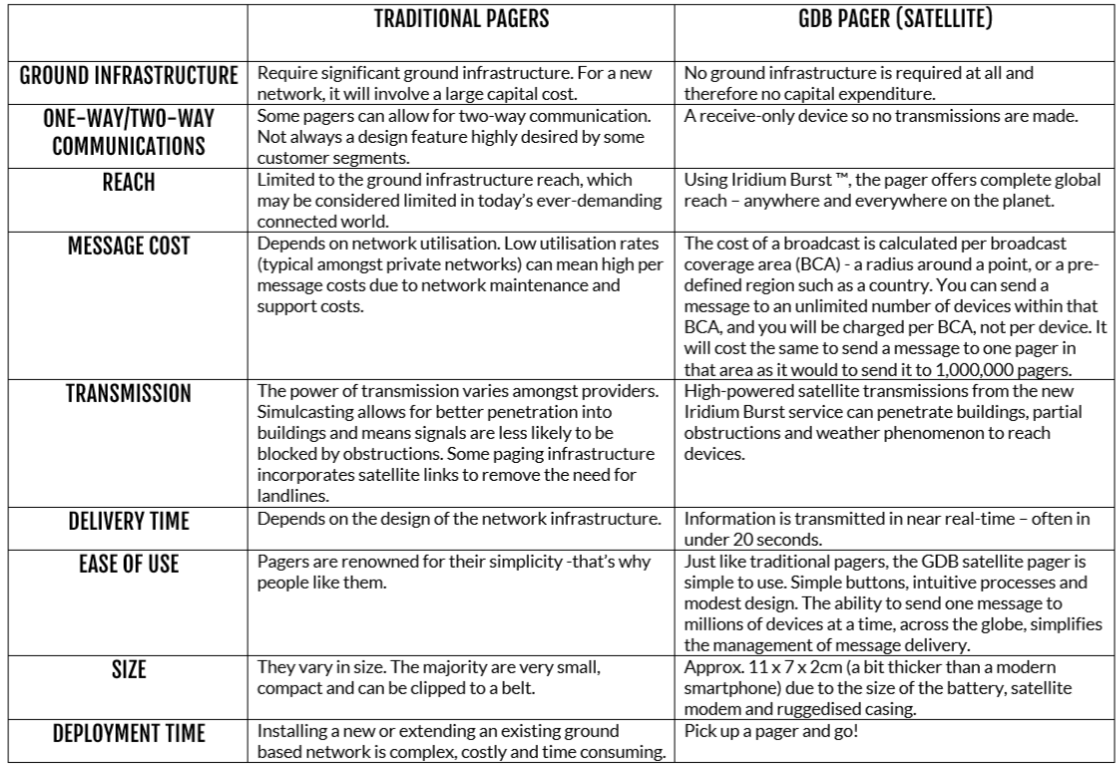|
Global Data Burst (GDB) has announced that it will shortly be launching a trial version of its Traffic Pattern Obscuration Technology (TPOT, pronounced ‘teapot’) on its communications portal. The TPOT platform protects communications through the GDB Portal from analysis by eavesdropping transmissions from the Iridium satellite constellation that is used to deliver its messages.
Traffic pattern analysis has a long history with its roots in the Second World War and is typically used to imply extant or imminent activity associated with a particular pattern of message traffic. Although the content of messages is protected by encryption, intelligence can still be derived from the mere existence of messages. The TPOT platform eliminates this possibility.4 "We believe this functionality will be of interest to existing users and customer segments where there is a high sensitivity to security” said Trevor Drawbridge, Director at Global Data Burst responsible for the TPOT programme. Trevor has been involved with data communications throughout his working life, including time with the UK’s MoD. “The platform design allows varying levels of sophistication to be deployed to suit individual users needs”, Trevor explained, “In fact, our TPOT technology has a wider applicability than the GDB Portal”.
0 Comments
We are exhibiting at Iridium Partner Conference in Nashville, Tennessee from Wednesday 26 - Thursday 27 September 2018. The two-day networking event will be a catalyst for collaboration - bringing leaders of the dynamic, ever-expanding Iridium ecosystem together with ideas, innovations, and opportunities - all in one place, at the same time.
Global Data Burst has adopted a modular paradigm to the use of our GDB Transfer product. This modular approach enables major functionality to be separated into discrete modules. The objective is to enable different modules to be connected together to suit specific end user requirements. The way this is achieved is to standardise the interfaces between modules where possible. The major benefit of this approach is that varied end user applications can make use of standard modules thus reducing engineering costs.
An example of this approach is the GDB Repeater product which contains three modules.
All three are available off-the-shelf. The Processor module has been programmed with firmware that implements the Repeater functionality, no custom hardware has been developed of modified. The modular approach is a 'way of thinking' that whilst providing a framework for development does not dictate rigid boundaries. The resultant flexibility allows the design process to migrate away from the starting modular concept to best suit the requirements of the end user application. Using the modular approach as the starting point however minimises the costs incurred with any bespoke development. Click here to find out more about GDB Transfer. Iridium Burst is the first one-to-many global data broadcast service, making it possible to transmit data to millions of enabled devices at a time. The low-latency service can transmit data globally via the Iridium network with transmissions that can even be received indoors.
Global Data Burst (GDB) was the first company to actively test the Iridium Burst service. During these tests, we found that penetration of the Iridium Burst signals into buildings, strongly depends on the elevation of the satellite. At very low elevation angles, it is likely that the signal must travel a longer distance through the building’s construction materials and therefore suffer additional loss compared to signals from satellites that are overhead. This can lead to situations where critical lifesaving messages will not be received. To overcome this issue and enhance the system’s overall performance, GDB have developed GDB Boost, an indoor signal booster, to compliment the GDB Pager. The GDB engineering team were tasked with creating a product which; “is simple to install”, “does not use any energy” and “is user friendly”. The awesome GDB team, of course delivered on all three major requirements and developed a solution where two passive Iridium antennas are connected through a coaxial cable. So, how does it work?... An outdoor magnetic antenna is placed outside to receive the Burst signal and an indoor antenna re-transmits the Burst signal to the GDB Pager. Users simply place the GDB Pager on top of the indoor antenna to boost the signal. Depending on the connecting coaxial cable, the transmission can travel between the indoor and outdoor antennas by up to 20 metres! Indoor performance tests of the Iridium Burst service, with over 10,000 GDB Pager messages sent, have shown a reliability of over 99.99%. With such a high degree of reliability, the GDB Pager combined with GDB Boost, using the Iridium Burst service, is a serious candidate for pager applications where reliability is of the utmost importance. For more information on GDB Boost, please get in touch info@globalalerting.com Okay, so you might be in the majority who think that pagers aren’t cool, but here’s hoping I change that – or at least get you thinking about pagers again. Stereotyped nowadays for only being used by birdwatchers, coastguards and medics, the trusty pager, believe it or not, is still deemed a vital bit of kit! The beeping business that seems ancient in the age of smartphones, I’ve found, is still very much treasured in certain parts of the world, by certain organisations and by certain groups of people. Admittedly, the facts and figures do show that fewer people are using pagers, but that’s not to say that people don’t want them! Is it the way they look, is it the technology, or is it that they are just deemed useless? Most traditional pagers certainly look dated in today’s comms gadget landscape. I don’t think there would be any tech-savvy person in this world who would be proud to show off their 80’s belt clipped pager. Having said that, paging people are practical people and want a device that can do a job and do it well. If it hasn’t got an edge to edge display or OLED screen, well frankly, that doesn’t matter. Some beep, some speak and some give you text messages – hardly big selling points. Put simply, the only real advantage of traditional pagers is their reputation for having slightly better reliability. Where mobile phone networks are patchy, the alternative separate paging network does offer a modest improvement, but with more and more paging services suppliers dwindling into nonexistence, it raises the question as to whether paging networks are sustainable. With the expense of ground infrastructure, limitations of reach and lack of secure communications being the main causes of the decline in pager popularity, are satellite networks the answer to bring the pager into the 21st century? Although satellite paging has been achieved in the past, the software and reception limitations and hardware capabilities have severely constrained the feasible range of applications, until now. The new Iridium Burst ™ service (which is fully supported in the new Iridium NEXT constellation) has enabled GDB to deliver a truly global satellite paging solution, that abolishes the issues found with traditional pagers. We’re making pagers cool again. How does satellite pager compare to traditional wide area paging? Have a look at the table... So, does the introduction of this new satellite pager to the market make the pager cool again? - Maybe not to the 80’s pager consumer market, but it’s definitely a cool gadget for certain groups of people (not just us GDB lot). Trevor DrawbridgeDirector, Global Data Burst Ltd.
Today, pagers are embraced by the same groups who used the very first versions. Pagers remain popular because of the reliability of the paging networks. Some argue that until cellular networks can match the survivable architecture of the paging networks, pagers will remain a staple of critical communications for years to come... but is there an even better solution to this so called “survivable architecture”? We think so. #GDBPager #ThrowbackThursday
GDB is bringing the pager into the 21st century. The GDB Pager exploits the new Iridium Burst service to provide a truly global satellite paging solution that abolishes the issues found with traditional pagers.
Richard Prodger, Technical Director, says, “Whilst satellite paging has been achieved in the past, the reception limitations, software deficiencies and hardware capabilities have severely constrained the feasible range of applications. The GDB Pager allows you to send a message to anyone, anywhere, at any time. Whether you are indoors or outside, on the North Pole or in the middle of the sea – we’ve got it covered!” Trevor Drawbridge, Director, says “Not only have we completely removed the need for ground infrastructure, the satellite signals can penetrate buildings, partial obstructions and weather phenomenon. We have made it possible for people to transmit messages to tens, hundred, thousands, even millions of devices at the click of a button – with a pricing structure that doesn’t break the bank. From tsunami warnings to weather and traffic alerts, the GDB Pager presents an unrivalled opportunity for businesses, government agencies, military and other entities to broadcast and receive data.” Jan ten Thije, Product Director, says “The first version of the pager has been designed to withstand rough treatment and use in rough conditions. Security of messages is a major focus for us, through encryption and closed groups we ensure that only authorised pagers receive the messages.” The main board within the device was designed with the future in mind. GDB is already working on products for the M2M and IoT markets using the same board. GDB is taking orders for the first version of the GDB Pager and supporting products. To find out more about distributor/reseller partnerships please email info@globaldataburst.com. |
|
Global Data Burst is a limited company registered in England and Wales. Registered number: 09950060. Registered office: Broomvale Business Centre, Bramford Road, Ipswich, Suffolk, IP8 4JU, United Kingdom.










